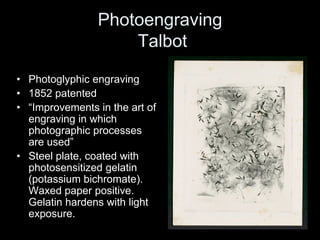Medium Matters: Photography in the Age of Mechanical Reproduction discusses various photographic mediums used in books from the 19th century. It covers salted paper prints, cyanotypes, albumen prints, carbon prints, Woodburytypes, and platinum prints. Each process is described in terms of its history, technology, identification, and preservation. The document aims to educate readers on the various photographic mediums found in books and why studying these processes is important.


































![Carbon
• Patented 1855 by
Alphonse Louis Poitevin;
modified 1866 by Joseph
Swan
• Popular 1864-1910,
though artists continue to
use variant techniques
• Named for carbon black
pigment often used in the
process
• Autotype, pigment
printing Adolphe Braun, [Façade Detail of South Portal Showing Wise
Virgins, Strasbourg Cathedral], 1859, printed ca. 1865, The
Metropolitan Museum of Art, Gift in remembrance of
September 11, 2001, from Charles Isaacs and Carol Nigro,
2001 (2001.757)](https://image.slidesharecdn.com/wsmm-ppt-101020003917-phpapp01/85/Ws-mm-ppt-35-320.jpg)








































![Letterpress Halftone
• Printed on any paper in any color
or any combination of colors
• Distinctive dot pattern, often
compared to waffle or
checkerboard, can usually be
seen with the naked eye
• Ink thicker at edge of dot, in dense
areas, the larger dots join
• Dot size less refined in 19th
century
• Detail is difficult to capture, lacks
contrast, “flat”
• Slight indentation wherever ink
deposited
• Text and image can be printed
together
Otto Kraft, [Woman’s Face Through Halftone Screen],
1930, Ford Motor Company Collection, Gift of Ford
Motor Company and John C. Waddell, 1987
(1987.1100.317)](https://image.slidesharecdn.com/wsmm-ppt-101020003917-phpapp01/85/Ws-mm-ppt-76-320.jpg)



![Gelatin and Collodion POP
• Paper thicker than albumen, very
smooth, burnished surface; collodion
papers also appeared in matte
surface, which resembles platinum
prints
• Often highly glossy; can be confused
with ferrotyping of developed-out prints
• Bright whites though baryta layer
sometimes tinted pink or blue
• Tend to be blue/purple in tone but
available in a variety of tones,
surfaces, and contrasts
• Difficult to distinguish from albumen
prints and some DOPs
• Characteristic deterioration includes
overall fading and larger losses of
emulsion where creased or chipped Unknown Artist, American School, [Buffalo Bill Cody and Members
of His Wild West Show], 1890s, The Metropolitan Museum of Art,
Gift of M. Knoedler and Co., Inc., 1958 (58.553.44)](https://image.slidesharecdn.com/wsmm-ppt-101020003917-phpapp01/85/Ws-mm-ppt-80-320.jpg)
















